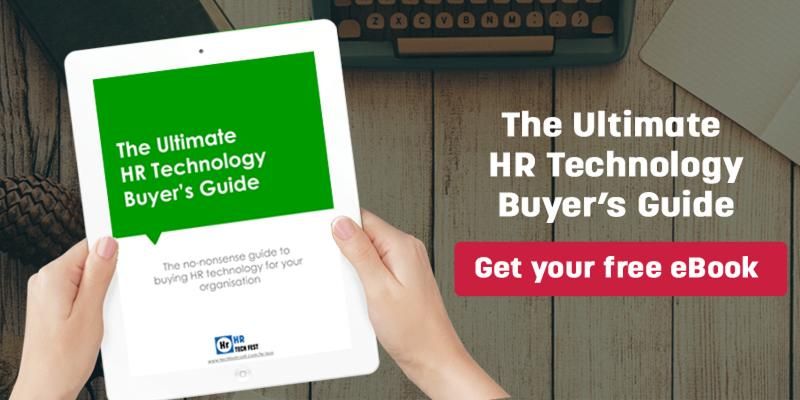What You Need To Know About the Future of HR Tech
)
Who am I to say? The first five years of my career were spent advocating for candidates; building core engineering teams at startups up and down the west coast as a localized and specialized tech recruiter. The second five years as a Talent Engineer, and most recently, the People Tech Innovation Lead at a global internet company. In particular, my current role requires that I spend ample time researching and reviewing potential solutions in the HR and Recruiting Technology space.
            “Recently I told a group of HR and recruiting professionals that they should keep up with the ever-changing HR technology market by participating in 3-4 software demos a week.â€' – William Tincup
I'll be sharing my story at HR Tech Fest in Melbourne on 27-29 November 2016. In the meantime I'm writing this post and sharing it with you because I am passionate about helping people at scale and leveraging technology to do so.
ConsiderationsThe Mission – Identify and deliver people tech solutions which empower people and productivity.
The User Experience – User-centric, simple, and productive.
The Landscape – This post is the result of reviewing 20+ software solutions in the HR and Recruiting technology space over the past 12 weeks. The software solutions were aimed at some areas including, but not limited to:
- Employer Branding
- Sourcing
- Applicant Tracking System (ATS)
- Assessment & Stack Ranking
- Onboarding
- Workforce Management Platform
- Job Board / Aggregators
- Employee Referral
- Learning & Development
- Outplacement & Alumni Software
People tech innovation is here to stay! That said, we are in the infancy stage, and the current solutions in the market will require more commitment and longer, more continuous development cycles to claim innovation. The current fragmentation leaves me concerned, yet, encouraged that the industry will punch through this stage of innovation as long as we continue to remember the user(s) matter most, and to collaborate with one another.
Areas where maturity will make a differenceUser Experience (UX):Â tools have done an adequate job of incorporating active UX principles into their product(s). That said, there is a noticeable gap between the UX of any one product and the holistic UX of a particular workflow. [recos 1 and 3 below]
Integration: system-system integration is still an issue in the enterprise environment. There are a limited number of systems that act as a “system of recordâ€' and unless you are building one of those systems, you have to integrate with said system of record. As the landscape matures, the roles and responsibilities of each player in the market will develop. [see recos 2 and 4 below]
Lack distinct point-of-view (POV): in talking to several companies, they want to help solve “all our problemsâ€' or “a lot of our problemsâ€' but haven't solved their own: product fit. “What will you augment or replace in my current environment and how will we measure the success or impact of your product?â€' was a tough question for them to answer. I see this struggle with enterprise solutions more than those aimed at early stage startups. The latter, have typically latched onto a niche problem and are solving it incrementally. [see reco 1 below]
Data:Â many of the apps have given users a way to export data, access basic reports, and maybe even basic access via a mobile app. That said, these stories are still naive and require additional (manual) manipulation before becoming actionable or directly valuable to HR/Recruiting leaders. Back to the integration gaps, the user is left to pull data from a variety of sources, which are typically not formatted similarly, to build basic dashboards. The act of providing a dash, for example, to manage up or out becomes rigorous and laborious on a weekly or monthly basis whatever your reporting cadence is. [recos 1 and 3]
Unit economics:Â that take into consideration current market trends and holistic budgeting. Talent might be front and center on the NY Times article you read this morning but regarding authority and budget responsibilities, the function still depends on other functions in most companies. As a vendor, this means your key stakeholder and your buyer are two different people. [recos 1 and 4 below]
Recommended collaboration- More domain expertise:Â those of us in the HR and recruiting industry who are passionate about helping people and using technology to do so, need to give our time and expertise to the makers of these solutions. It is up to us as HR and recruitment leaders to learn the technology, understand its value and how to use it, help shape the solution, and then make the business case to implement/execute.
- Build HR and recruiting teams to include program management skill sets earlier in the team-building process. Incorporate technology as a key strategy from day one: roll technology out as part of, even key drivers of, mission-critical people initiatives.
- More focus on the end user:Â I would encourage these companies to continue spending time with the community and learning as much as they can about the workflow from the end user's perspective.
- Leverage partnerships to come up with creative pricing models and overall better unit economics, which allow users to explore a multi-tier solution openly without fear of breaking the bank (or terrifying the CFO every time you ask for a few minutes).
I believe in the talent community and our ability to continue building relationships, careers, teams, companies, and software that make the world go round, one interaction at a time.
Disclaimer one: the opinions expressed in this post are my own, and in no way represent my employer.
This post originally appeared on LinkedIn Pulse.
About the Author
Erin Wilson (AKAÂ The Tech Matchmaker) is the Head of Talent Engineering at Yahoo. He is passionate about advocating for candidates and fascinated with the power that technology has to empower HR people to innovate.
He'll be sharing his story at HR Tech Fest in Melbourne in November 2016.
.png)

